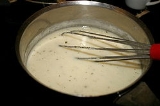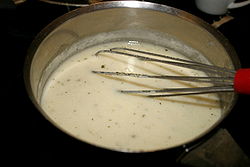
Roux
Encyclopedia

Flour
Flour is a powder which is made by grinding cereal grains, other seeds or roots . It is the main ingredient of bread, which is a staple food for many cultures, making the availability of adequate supplies of flour a major economic and political issue at various times throughout history...
and fat
Fat
Fats consist of a wide group of compounds that are generally soluble in organic solvents and generally insoluble in water. Chemically, fats are triglycerides, triesters of glycerol and any of several fatty acids. Fats may be either solid or liquid at room temperature, depending on their structure...
, traditionally butter
Butter
Butter is a dairy product made by churning fresh or fermented cream or milk. It is generally used as a spread and a condiment, as well as in cooking applications, such as baking, sauce making, and pan frying...
. It is the thickening agent of three of the mother sauces of classical French cooking: sauce béchamel, sauce velouté and sauce espagnole. Clarified butter
Clarified butter
Clarified butter is milk fat rendered from butter to separate the milk solids and water from the butterfat. Typically, it is produced by melting butter and allowing the different components to separate by density...
, vegetable oils, or lard
Lard
Lard is pig fat in both its rendered and unrendered forms. Lard was commonly used in many cuisines as a cooking fat or shortening, or as a spread similar to butter. Its use in contemporary cuisine has diminished because of health concerns posed by its saturated-fat content and its often negative...
are commonly used fats. It is used as a thickener for gravy
Gravy
Gravy is a sauce made often from the juices that run naturally from meat or vegetables during cooking. In North America the term can refer to a wider variety of sauces and gravy is often thicker than in Britain...
, other sauce
Sauce
In cooking, a sauce is liquid, creaming or semi-solid food served on or used in preparing other foods. Sauces are not normally consumed by themselves; they add flavor, moisture, and visual appeal to another dish. Sauce is a French word taken from the Latin salsus, meaning salted...
s, soup
Soup
Soup is a generally warm food that is made by combining ingredients such as meat and vegetables with stock, juice, water, or another liquid. Hot soups are additionally characterized by boiling solid ingredients in liquids in a pot until the flavors are extracted, forming a broth.Traditionally,...
s and stew
Stew
A stew is a combination of solid food ingredients that have been cooked in liquid and served in the resultant gravy. Ingredients in a stew can include any combination of vegetables , meat, especially tougher meats suitable for slow-cooking, such as beef. Poultry, sausages, and seafood are also used...
s. It is typically made from equal parts of flour and fat by weight. When used in Italian food, roux is traditionally equal parts of butter and flour. In Cajun cuisine
Cajun cuisine
Cajun cuisine is the style of cooking named for the French-speaking Acadian or "Cajun" immigrants deported by the British from Acadia in Canada to the Acadiana region of Louisiana, USA. It is what could be called a rustic cuisine — locally available ingredients predominate, and preparation...
, roux is almost always made with oil instead of butter and dark brown in color, which lends much richness of flavor albeit less thickening power. Hungarian cuisine uses lard (in its rendered form) or - more recently - vegetable oil instead of butter for the preparation of roux (which is called rántás in Hungarian).
Methods
The fat is heated in a pot or pan, melting it if necessary, then the flour is added. The mixture is stirred until the flour is incorporated, and then cooked until at least the point where a raw flour taste is no longer apparent and until desired color has been reached. The final results can range from nearly white to nearly black, depending on the length of time it is over the heat, and its intended use. The end result is a thickening and flavoring agent.Roux is most often made with butter as the fat base, but it may be made with any edible fat. In the case of meat gravies, they are often made with rendered fat from the meat. In regional American cuisine
Cuisine of the United States
American cuisine is a style of food preparation originating from the United States of America. European colonization of the Americas yielded the introduction of a number of ingredients and cooking styles to the latter...
, bacon is sometimes rendered to produce fat to use in the roux. If clarified butter is not available, vegetable oil is often used when producing dark roux, as it does not burn at high temperatures as does whole butter.
When combining roux with water-based liquids, such as broth or milk, it is important that these liquids are not excessively hot. It is preferable to add room temperature or warm roux into a moderately hot or warm liquid, or vice versa. To ensure the desired viscosity, they should be added in small quantities while stirring, briefly bringing the temperature up to boiling. Otherwise the mixture will contain lumps.
Cooks can substitute for roux by adding a mixture of water and wheat flour to a dish that needs thickening, since the heat of boiling water will release the starch from the flour; however, this temperature is not high enough to eliminate the floury taste. A mixture of water and flour used in this way is colloquially known as "cowboy roux," and in modern cuisine it is called a white wash, but is used infrequently since it imparts a flavor to the finished dish that a traditional haute cuisine
Haute cuisine
Haute cuisine or grande cuisine was characterised by French cuisine in elaborate preparations and presentations served in small and numerous courses that were produced by large and hierarchical staffs at the grand restaurants and hotels of Europe.The 17th century chef and writer La Varenne...
chef would consider unacceptable. Cornflour (known as cornstarch in the U.S.) can be used instead of wheat flour, as less is needed to thicken, and it imparts less of the raw flour taste, and it also makes the final sauce more shiny.
Types
Light (or "white") roux provides little flavor other than a characteristic richness to a dish, and is used in French cooking and some graviesGravy
Gravy is a sauce made often from the juices that run naturally from meat or vegetables during cooking. In North America the term can refer to a wider variety of sauces and gravy is often thicker than in Britain...
or pastries
Pastry
Pastry is the name given to various kinds of baked products made from ingredients such as flour, sugar, milk, butter, shortening, baking powder and/or eggs. Small cakes, tarts and other sweet baked products are called "pastries."...
throughout the world. Darker roux, sometimes referred to as "blond", "peanut-butter", "brown" or "chocolate" roux depending on the color achieved, add a distinct nutty flavor to a dish. For example, classic Swabia
Swabia
Swabia is a cultural, historic and linguistic region in southwestern Germany.-Geography:Like many cultural regions of Europe, Swabia's borders are not clearly defined...
n (southwest German) cooking uses a darker roux for its "brown broth" (braune Brühe), which, in its simplest form, consists of nothing more than lard, flour, and water, with a bay leaf and salt for seasoning. Dark roux is often made with vegetable oils, which have a higher smoke point
Smoke point
The smoke point generally refers to the temperature at which a cooking fat or oil begins to break down to glycerol and free fatty acids, and produce bluish smoke. The glycerol is then further broken down to acrolein which is a component of the smoke. It is the presence of the acrolein that causes...
than butter, and are used in Cajun
Cajun cuisine
Cajun cuisine is the style of cooking named for the French-speaking Acadian or "Cajun" immigrants deported by the British from Acadia in Canada to the Acadiana region of Louisiana, USA. It is what could be called a rustic cuisine — locally available ingredients predominate, and preparation...
and Creole cuisine for gumbo
Gumbo
Gumbo is a stew or soup that originated in southern Louisiana during the 18th century. It consists primarily of a strongly-flavored stock, meat or shellfish, a thickener, and the vegetable holy trinity of celery, bell peppers, and onions...
s and stew
Stew
A stew is a combination of solid food ingredients that have been cooked in liquid and served in the resultant gravy. Ingredients in a stew can include any combination of vegetables , meat, especially tougher meats suitable for slow-cooking, such as beef. Poultry, sausages, and seafood are also used...
s. The darker the roux, the less thickening power it has; a chocolate roux has about one-fourth the thickening power, by weight, of a white roux. A very dark roux, just shy of burning and turning black, has a distinctly reddish color and is sometimes referred to as "brick" roux.
Cretan staka
The staka is a type of roux particular to the cuisine of CreteCrete
Crete is the largest and most populous of the Greek islands, the fifth largest island in the Mediterranean Sea, and one of the thirteen administrative regions of Greece. It forms a significant part of the economy and cultural heritage of Greece while retaining its own local cultural traits...
. Its preparation begins by collecting the high-fat cream layer that forms on top of fresh goat milk, and refrigerating it. Once a sufficient quantity is collected, this butterfat is placed over low fire to melt. Then wheat flour or starch is gradually added: the protein-rich part of the butterfat coagulates with the flour or starch and forms the staka proper, which is served piping hot. Upon preparation, it is generally spread across bread or served on top of french fries.
The fatty part separates to form stakovoutyro, staka butter, which is then refrigerated for later use and has a faint cheesy flavor. This staka butter is used in Cretan piláfi, a local variation of pilaf
Pilaf
Pilaf is a dish in which rice is cooked in a seasoned broth . In some cases, the rice may also attain its brown color by being stirred with bits of cooked onion, as well as a large mix of spices...
commonly served in weddings.
Alternatives
As an alternative to roux, which is high in fat and very energy-dense, some Creole chefs have experimented with toasting flour without oil in a hot pan as an addition to gumbo. CornstarchCornstarch
Corn starch, cornstarch, cornflour or maize starch is the starch of the corn grain obtained from the endosperm of the corn kernel.-History:...
mixed with water (slurry), arrowroot
Arrowroot
Arrowroot, or obedience plant , Bermuda arrowroot, araru, ararao, is a large perennial herb found in rainforest habitats...
, and other agents can be used in place of roux as well. These items do not contribute to the flavor of a dish, and are used solely for thickening liquids. More recently, many chefs have turned to a group of naturally occurring chemicals known as hydrocolloids. In addition to being flavorless and possessing the ability to act as a thickening agent, the resulting texture is often superior, and only a small amount is required for the desired effect.

